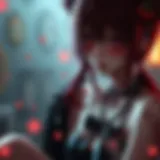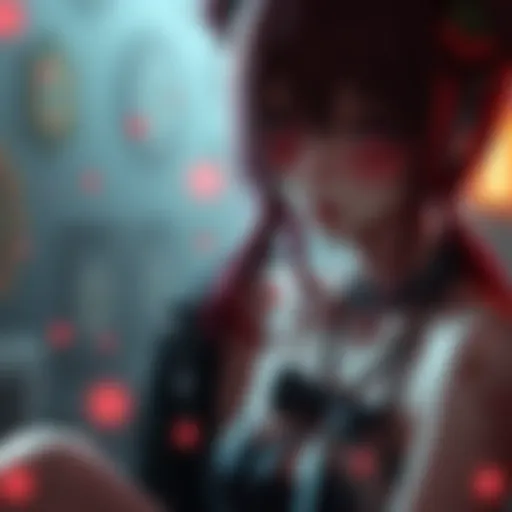Analyzing Harem Heroes in Anime: Archetypes and Dynamics
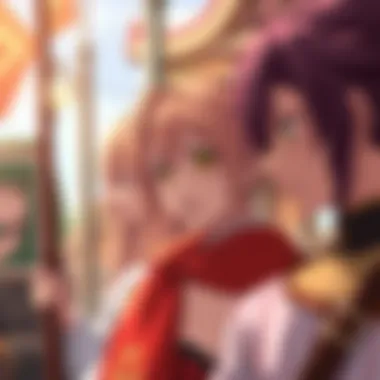

Intro
In the expansive world of anime, the character archetype of the harem hero stands out in a rather unique fashion. These protagonists often find themselves surrounded by a cast of female characters, each vying for their affection or attention. This narrative structure isn't merely for comedic or romantic effect; it reflects much deeper socio-cultural narratives and audience psyches.
Throughout this article, we aim to peel back the layers of what makes harem heroes tick. What drives them, and how do their relationships shape the stories they inhabit? This exploration will also reveal the various archetypes these characters embody, and how these portrayals evolve within the ever-changing landscape of anime culture.
The harem genre is not just a passing trend; it has firmly rooted itself in the hearts of fans, leading us to ponder its significance in contemporary storytelling. From the motivations of its heroes to the emotional nuances of their interactions with the many women around them, this piece will provide a rich tapestry of insights for readers eager to delve deeper.
As we guide you through this exploration, an understanding of the impact and reception of harem narratives within the anime community will unfold, providing context for why these stories captivate wide audiences and incur passionate discussions among fans.
Prolusion to Harem Genre
The harem genre has carved out a distinct niche in the realm of anime, captivating viewers with its blend of romance, comedy, and sometimes slice-of-life elements. By delving into the specific characteristics of harem anime, we not only uncover what makes it appealing but also explore how its overarching themes resonate with the audience's experiences and desires. This section serves as a gateway to understanding the intricacies involved in harem narratives, offering insights into the norms and expectations that shape the genre.
Defining Harem in Anime
At the heart of this genre lies the fundamental concept of a male protagonist surrounded by multiple female characters, each vying for his affection. The term 'harem' itself, originally derived from Arabic, refers to an area reserved for women, often portraying a space of intimacy and possessiveness. In anime, this translates into a storytelling mechanism where one central character navigates various romantic relationships. This protagonist doesn't necessarily engage deeply with every character; often, their interactions serve more to develop a comedic or dramatic tension rather than genuine emotional connections.
Common Characteristics Include:
- A clear male lead—often depicted as an everyman or an underdog.
- Multiple female characters, each with distinct personalities and backgrounds.
- Varying degrees of romantic interest from the female cast towards the protagonist.
- Situational comedy that stems from misunderstandings or romantic rivalries.
In defining a harem, one must also consider the nuances that differentiate it from other romance subgenres. Unlike reverse harems, which showcase female protagonists with multiple male admirers, traditional harems focus primarily on the male perspective. This structure facilitates a greater exploration of male fantasies and societal views on romance and relationships, providing fertile ground for both character and plot development.
Historical Context of Harem Anime
The harem genre can trace its roots back to various forms of literature and media, but it truly blossomed in anime during the late 1990s and early 2000s. As more series began to surface featuring a male lead with an array of female characters, the layout became almost formulaic yet appealing in its predictability. One of the earliest examples is Tenchi Muyo!, which paved the way for the genre by introducing complex character dynamics and supernatural elements, all wrapped in comedy and romance.
As the genre evolved, it began to reflect changing societal norms and attitudes toward relationships. With titles like Love Hina and Nisekoi, the narrative expanded beyond just comedic misunderstandings to include themes of personal growth, friendship, and even emotional maturity among the characters. These stories tapped into the viewer's desire for connection and intimacy, albeit in a fantastical guise.
Harem anime often serves as a mirror to society, showcasing ideals, aspirations, and sometimes the struggles of contemporary relationships. From the original tropes of the genre to newer interpretations that challenge gender dynamics, the exploration of harem anime roots draws attention to cultural shifts, making it an important aspect of the anime landscape.
"Harem anime isn't just about romance; it reflects our own quirks and intricacies in relationships, often exaggerating them to the realm of comedy or fantasy."
Recognizing the historical context of harem anime helps enthusiasts and scholars alike appreciate its evolution and the specific cultural narratives it engages with. As we continue to explore harem heroes, understanding the foundations becomes essential in discerning their impact on the broader anime genre.
Characteristics of Harem Heroes
When discussing harem heroes, it’s essential to understand their characteristics. These traits not only define who they are within the narrative but also highlight significant elements that draw audiences in. Harem heroes serve as conduits for the exploration of relationships and dynamics that often resonate with viewers in different ways.
The significance of these characteristics is multi-faceted. For starters, they help shape the stories in which they appear, influencing plot development and character interactions. Moreover, they often embody the fantasies and desires of the viewers, making them relatable or aspirational figures. In a genre that intricately weaves romance and comedy, the characteristics of harem heroes establish the groundwork for compelling arcs and character development. Each hero represents distinct archetypes that can lead to various viewer interpretations and emotional engagements.
Common Traits and Archetypes
In a landscape filled with diverse narratives, harem heroes can be classified into recognizable archetypes. Typically, they share certain fundamental traits that, while varying in intensity among different characters, remain consistent throughout the genre.
- Protagonist Characteristics: More often than not, harem heroes are positioned as somewhat ordinary individuals, which creates relatability. This could range from being an unremarkable high school student to an aspiring artist navigating through challenges.
- Kindness and Compassion: It's not unusual for these characters to showcase an unwavering kindness or empathy. This characteristic endeavours to highlight their moral standing, making them more likable, especially in contrast to the sometimes aggressive personalities of their female counterparts.
- Indecisiveness: Another commonality among these heroes is their indecision regarding relationships. Juggling multiple love interests often leads to awkward and comedic situations, which is a driving element of the narrative. Their hesitation often reflects the complexities of real-world relationships, tapping into deeper emotional layers.
- Idealism: Harem heroes sometimes carry an idealistic view of love and relationships. They may get swept away in romantic fantasies, which can resonate with viewers longing for such experiences.
Recognizing these traits not only adds depth to the characters but also reflects the varied desires and fantasies deep-rooted in the audience's psyche.
The Role of Innocence and Naivety
Innocence and naivety are delicate assets in the characteristic bouquet of harem heroes. These qualities manifest in several ways, often creating situations rife with humor or poignant realizations.
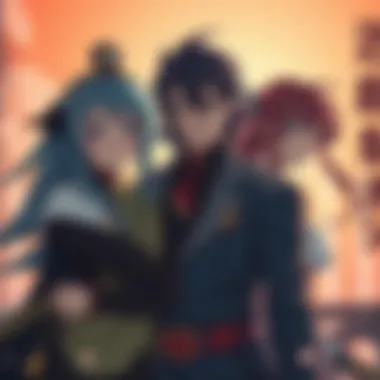

In many scenarios, harem heroes are portrayed as blissfully unaware of the romantic advances directed at them, which results in often hilarious misunderstandings. This oblivious nature permits other characters to evolve in response, fostering tension and engagement as the audience anticipates how these dynamics will unfold.
- Relatability: For many viewers, the innocence displayed by harem heroes mirrors their own experiences or aspirations. In a world where romantic pursuits can seem daunting or convoluted, these characters serve as comforting reminders of a simpler quest for love.
- Character Growth: As the narrative evolves, the innocence of harem heroes often leads to significant growth. The eventual realizations confront them with complex emotional landscapes, transforming their naivety into a more mature understanding of relationships.
In essence, the combination of these attributes not only elevates the character's relatability but encourages a deeper engagement with the narrative. The interplay of traits and their eventual growth becomes a critical element the viewers invest in emotionally.
"The nuances of harem heroes lie in their simplicity. Their blend of characteristics initiates a dance between fantasy and reality that many viewers find appealing."
Through analyzing the characteristics that define harem heroes, one can discern how these well-crafted figures remain compelling, enhancing both the narrative and viewer experience in anime.
The Dynamics of Relationships in Harem Anime
The realm of harem anime often thrives on complex relationships, painting a vivid tapestry of emotions, conflicts, and connections. This section uncovers the nuanced interplay between protagonists and female characters, alongside the rivalries that subsequently emerge from these dynamics. Understanding these relationships not only sheds light on individual character traits but also reveals the cultural undercurrents driving the harem genre.
Protagonist and Female Characters
At the heart of every harem narrative lies the protagonist, typically a young male surrounded by multiple female characters, each possessing distinct personalities and arcs. The protagonist often embodies traits like innocence or relativity, which makes it easier for viewers to project themselves onto him. However, the female characters are not just mere muses; they are crafted with depth, presenting various emotional or intellectual challenges. For example, characters such as Kirito from Sword Art Online are often paired with strong-willed females like Asuna. This fosters a balance where the male protagonist's weaknesses are offset by the female leads' strengths.
The relationships develop through various stages, showcasing how each female character influences the protagonist’s growth. The interactions aren’t purely romantic; they often involve friendship, jealousy, and rivalry. Such relationships can also serve as a microcosm for societal issues, addressing topics like gender roles and emotional intelligence.
These character dynamics compel viewers to evaluate their own perceptions of relationships. As audiences tune into the unique chemistry between characters, they find themselves reflecting on their own experiences, which makes the narrative more engaging.
“Harem anime captures the essence of emotional connection, allowing viewers to explore multifaceted relationships within safe boundaries.”
Conflict and Rivalry Among Love Interests
Conflict forms the backbone of harem stories, driving both character development and plot progression. Each female character typically represents different facets of love and desire, leading to inevitable rivalries. This constant tug-of-war creates tension, heightening the stakes involved in the protagonist’s choices. Take the character of Rintarou Okabe from Steins;Gate; his relationships with Kurisu and Mayuri highlight competing emotional ties that complicate his journey.
Rivalries can manifest in various forms, such as comedic misunderstandings or intense confrontations. This tension serves to advance the narrative, urging the protagonist to make significant decisions. In several instances, these rivalries catalyze character growth, prompting the protagonist to evaluate the depth of each relationship and what they truly yearn for.
Through this exploration of conflict, harem heroes not only grow but also reflect a broader dialogue about love, commitment, and choice. The viewers often find themselves rooting for one character over the other, adding layers of depth to the viewing experience. As rivalry unfolds on screen, it invites the audience to ponder ethical dilemmas and the complexities of human emotion, making harem anime not just a genre about superficial attractions, but a nuanced exploration of relationships at their core.
Understanding the dynamics at play allows fans to appreciate the intricate storytelling and character development that harem anime has to offer. These relationships, filled with laughter and tears, create a unique viewing experience that resonates with its audience.
Societal Reflections in Harem Narratives
The world of harem anime provides a unique lens through which to examine societal norms and values. This genre often mirrors—and sometimes distorts—real-life interactions among genders, reinforcing traditional narratives while simultaneously offering commentary on contemporary social climates. Analyzing these reflections is crucial as it allows us to see how harem heroes can act as vessels for discussing broader themes such as love, power dynamics, and gender roles.
Reinforcement of Gender Dynamics
At the heart of many harem narratives is the portrayal of gender dynamics that echoes societal expectations. Often, the male protagonist finds himself surrounded by multiple female characters, each representing different aspects of femininity. Thus, the harem hero frequently embodies a form of idealized masculinity that seems to hold dominion over submissive female figures. This setup can reinforce certain stereotypes, such as the notion that men should be assertive, while women should be nurturing and accommodating.
However, it's not all black and white. Some harem anime challenge classic constructs by depicting strong female characters who defy these stereotypes. For example, series like Ouran High School Host Club and The Quintessential Quintuplets see the female characters displaying agency and independence, at times even rivaling the male character's influence. These instances highlight how harem narratives can function as a battleground for evolving gender roles.
"Harem anime often portray a complex interplay of dominance and submission, reflecting the societal norms and ideals of romance in a way that’s both provocative and thought-provoking."
In this sense, harem heroes sometimes serve as a mirror, reflecting societal expectations back to the audience while also offering a space for questioning and redefining those very narratives. The intricate dynamics among characters allow anime viewers to consider their perspectives on relationships and societal norms more deeply.
Exploration of Male Fantasy
Harem anime often taps into the realm of male fantasy, presenting scenarios where one male character is adored by multiple female counterparts. This fantastical situation can act as a form of escapism for viewers who might fantasize about being the center of attention amid a variety of romantic interests. The harem hero often represents the idealized self that many viewers aspire to be—charismatic, likable, and successful in attracting desirable partners.
Yet, the exploration goes beyond mere escapism. It raises numerous questions about the nature of these fantasies. For example, are these portrayals reinforcing unhealthy ideals of masculinity? Do they contribute to unrealistic standards of relationships? In Date A Live, the protagonist's ability to charm various female characters may be thrilling, but it also invites scrutiny about the implications of these interactions. Are the relationships genuine, or are they merely setups for male gratification?
In a nutshell, while harem anime provides a playground for exploring male desires, it also challenges viewers to reflect on what those desires suggest about society and themselves. The genre pushes the envelope by questioning whether such fantasies are healthy or destructive, forcing audiences to weigh their allure against the real-world consequences of idealizing these relationships.
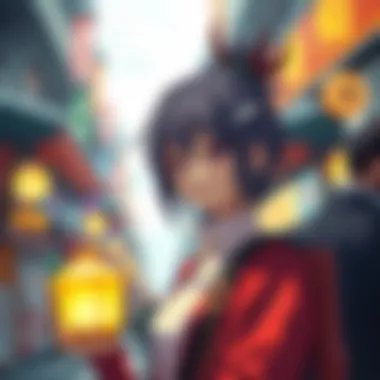

In summary, harem narratives do more than just entertain; they prompt a broader conversation around gender dynamics and the nature of male fantasy, making these themes profoundly relevant in today’s cultural landscape.
Evolution of Harem Heroes Over Time
The evolution of harem heroes in anime is a compelling narrative that mirrors shifts not only in storytelling but also in societal norms and expectations. Historically, the portrayal of male protagonists navigating relationships with multiple female characters has transformed significantly. Starting from the simplistic archetypes of the early harem stories, such as those found in Tenchi Muyo!, to the more complex and nuanced characters seen in recent works like My Teen Romantic Comedy SNAFU, it’s clear that the role of harem heroes has been in a state of flux. This transformation is crucial for understanding how harem dynamics serve as a reflection of wider cultural movements, particularly regarding gender roles, romance, and individuality.
Changes in Character Development
In earlier harem anime, characters often lacked depth. The male protagonist would typically be portrayed as naive and unremarkable, primarily serving as a vehicle for a series of comedic misunderstandings and scenarios. Commonly, the harem members were mere archetypes: the shy girl, the aggressive childhood friend, and the aloof beauty. For instance, in older shows, these characters seemed to exist merely to fill the space around the hero and create tension over whom he would choose.
Over time, character development for harem heroes has taken a more sophisticated turn. More recent anime have focused heavily on the internal struggles of these protagonists. The male lead is often portrayed with insecurities and emotional depth, making them relatable to the audience. A notable example is Kaguya-sama: Love Is War, where the protagonist’s and his love interests’ intricate psychological games reveal their vulnerabilities and complexity. This nuanced portrayal leads to richer storytelling, allowing viewers to engage deeply with the characters and their relationships, rather than passively consuming a light-hearted romance.
It’s worth mentioning that this shift toward complexity isn’t without challenges. Writers must navigate the fine line between developing a fully-rounded character and keeping the light-hearted and comedic nature that draws fans to the genre. Success in this realm often hinges on balancing relatable character flaws with the comedic quirks that can make for engaging entertainment.
Response to Viewer Expectations
As anime continues to evolve, so do the expectations of its viewers. The shift toward more detailed character development illustrates a broader trend in the animation industry: the push for more complex narratives. Audiences today crave depth not just from the protagonists but from the overall story arcs.
Older audiences might resonate with the nostalgia of classic harem tropes, but younger fans often demand stronger narratives that offer more than just surface-level interactions. Shows like Horimiya exemplify this, presenting well-developed characters with authentic relationships that evolve meaningfully throughout the series. The expectation now is not only for harem heroes to earn their place in multiple romantic interests but also to explore their identities amid conflicting emotional landscapes.
Moreover, series like Re:Zero - Starting Life in Another World push this idea further by allowing protagonists to confront trauma and make hard choices that affect their relationships deeply. As a result, the genre must adapt or risk losing engagement and relevance in an audience that increasingly values substance over style. This impact reflects broader trends in media consumption, with viewers favoring character-driven plots over formulaic storytelling.
In summation, the evolution of harem heroes underscores a significant shift within anime as a whole, responding to not only the changing tastes of audiences but also engaging in deeper storytelling that resonates well beyond the happy-go-lucky surface of the genre. The journey of these characters remains reflective of broader societal values—challenging traditional norms, exploring emotional growth, and addressing the notions of fantasy versus reality in relationships.
Critical Reception of Harem Anime
The critical reception of harem anime plays a vital role in understanding how these narratives resonate with audiences. It offers insights into the wider social and cultural implications of the genre. By examining various perspectives from critics and viewers, we gain a multidimensional view of how harem heroes and their stories have evolved over time. This exploration not only reflects the shifting landscape of anime fandom but also highlights the complex relationship between entertainment and societal norms.
Audience Demographics
The audience for harem anime is incredibly diverse, ranging from teenagers to adults. This demographic diversity is noteworthy because it speaks volumes about the genre’s appeal across different age groups and cultural backgrounds. In recent years, there has been a noticeable uptick in female viewers engaging with harem narratives, challenging the historical perception that these shows are primarily targeted toward male audiences.
- Young men (ages 18-24): Traditionally the core audience, this group often finds resonance with the male protagonists' journey through romantic entanglements.
- Young women (ages 18-24): Increasing numbers of female fans appreciate the emotional nuances and variety of character dynamics, offering a fresh perspective on male-driven stories.
- Older adults: Many older viewers are drawn to the nostalgia factor or the exploration of relational themes that reflect their own life experiences.
These demographics enrich the reception of harem anime, allowing for varied interpretations and discussions among fans. The expansion of the audience base has also pressured creators to diversify storylines and character archetypes, leading to a broader representation within the genre.
Analysis of Viewership Trends
Analyzing viewership trends sheds light on the evolving landscape of harem anime and its reception. With the rise of streaming platforms like Crunchyroll and Funimation, data shows that harem titles are increasingly accessible to a global audience. This availability has resulted in an uptick in international viewership and discussions around these works.
A few notable trends include:
- Cross-genre experimentation: Many recent harem anime blend elements from other genres like fantasy, mystery, or thriller, refreshing the traditional narrative.
- Shorter seasons: More series are opting for shorter run-times, creating a quicker, more digestible viewing experience that taps into the rapid consumption habits of modern audiences.
- Focus on character depth: There's a shift toward more nuanced characters, which has been positively received by critics, suggesting a maturity in storytelling that resonates with both new and long-time fans.
Moreover, social media platforms serve as hubs for fan discussions, influencing the viewership trends by creating a strong community around popular titles. This active engagement boosts the visibility of newer titles and fosters a shared understanding of the genre, hence influencing future adaptations and storylines.
Overall, the critical reception of harem anime, from understanding audience demographics to analyzing viewership trends, is essential in mapping out its cultural significance and longevity within the anime landscape.
Harem Heroes in Popular Culture
The realm of anime is rich and diverse, and within this tapestry, harem heroes have carved out an intriguing niche. These characters are not just focal points of romantic entanglements; they serve as cultural mirrors, reflecting broader societal norms, values, and fantasies. Their influence on popular culture is profound, impacting everything from merchandise to community discussions and subcultural movements.
In examining the significance of harem heroes, we should consider several elements:
- Cultural Reflection: Harem heroes often embody the values and aspirations of their respective societies. For instance, their interactions with multiple female characters can offer insights into contemporary views on romance, masculinity, and societal roles.
- Character Archetypes: These protagonists frequently draw from archetypes that resonate with fans. The shy boy-next-door or the overconfident jock can harmoniously coexist with diverse female personas, creating a dynamic that appeals to a wide audience.
- Narrative Structure: The way harem stories are told contributes to their popularity. The episodic nature of many harem anime allows for ongoing character development and relationship progression, keeping viewers engaged over time.


"The harem genre invites viewers into an intricate dance of affection and rivalry, where each character adds layer upon layer to the narrative's depth."
Ultimately, the representation of harem heroes in anime not only entertains but also sparks discussions about attachment styles, gender roles, and even life choices among fans. Each character's journey can facilitate conversations about personal relationships, enhancing viewer engagement in ways that extend beyond mere screen time.
Iconic Characters and Their Influence
When discussing harem heroes, several iconic characters emerge as pivotal figures whose influence transcends their respective series. These characters often epitomize certain qualities that resonate with fans, making them household names.
- Keima Katsuragi from The World God Only Knows is notable for his tactical approach to romance, treating it like a video game. His analytical mindset provides a fresh perspective on the harem genre, making fans rethink romantic engagements entirely.
- Kirito from Sword Art Online might also feature on many lists, with his complexity and development throughout different arcs showcasing how a harem hero can evolve in response to narrative demands.
- Nisekoi's Raku Ichijo illustrates an ordinary boy thrust into extraordinary circumstances, depicted through his romantic troubles with multiple girls, captivating the audience with his every choice.
These characters not only bring stories to life but also set standards for character development across the harem spectrum. Their popularity inspires various merchandise, from figurines and posters to themed cafes that celebrate their journeys.
Adaptations and Spin-offs
The success of anime harem heroes has led to numerous adaptations and spin-offs that keep the essence of these characters alive in various formats.
- Light Novels and Manga: Many harem series begin as light novels or manga, establishing a dedicated fanbase before being adapted into anime. This transition often expands the story's universe, providing richer backstories and character dynamics.
- Video Games: Several harem titles have also been transformed into video games, enhancing interactivity and player agency. Titles like Danganronpa have pulled in players to enjoy storylines that allow them to navigate relationships on their terms.
- Merchandising and Events: Events like Anime Expo and conventions often see a surge in merchandise celebrating harem characters. Collectible items provide fans with tangible ways to engage in their love for these narratives.
In essence, the versatility of harem heroes across different formats illustrates not only their cultural significance but also their adaptability to consumer tastes. As these characters hop from one medium to another, they create a multifaceted experience for fans, ensuring their place in the annals of pop culture.
Future Trends in Harem Anime
The realm of harem anime is ever-evolving, reflecting shifts in societal norms, audience preferences, and advancements in technology. This article section examines the emerging themes and variations within the genre, as well as how technological advances are shaping the future landscape of harem narratives. Understanding these trends offers insight into not just what harem anime is today, but also what it may become tomorrow.
Emerging Themes and Variations
Harem anime is no longer a one-size-fits-all genre. As creators push boundaries, several themes are surfacing that give rise to varied narratives:
- Diverse Character Depth: The stereotypical portrayal of characters is gradually being replaced by more multifaceted personalities. Recent harem titles have been showcasing characters with distinct backgrounds, motivations, and growth arcs, resonating with viewers who seek authenticity.
- Cross-Genre Blends: The fusion of harem with genres such as fantasy, sci-fi, and even horror has opened new avenues for storytelling. Combining the harem formula with action or psychological elements introduces fresh dynamics and increases the stakes for protagonists.
- Realism in Relationships: More recent works are tackling the complexities of relationships with a touch of realism. This means addressing issues such as consent, emotional baggage, and personal development, providing a more nuanced take on the romantic entanglements that characterize harem anime.
By pursuing different themes, writers can attract both seasoned fans and newcomers, giving the genre renewed life.
Technological Advances and Their Impact
The integration of technology within harem anime's production and distribution reflects broader trends in the anime industry:
- Animation Quality Improvements: The leap in animation technology has allowed for visually stunning sequences in harem anime. This enhancement does not just serve aesthetics; it elevates emotional moments and makes character interactions more engaging.
- Streaming Platforms: The rise of dedicated anime streaming services like Crunchyroll and Funimation have changed how audiences consume harem anime. With on-demand access, fans can easily discover new titles, fueling the genre's growth by introducing lesser-known series to a wider audience.
- Interactive Storytelling: The introduction of interactive narratives, where viewers can influence plot outcomes, has started to seep into anime. Imagine a harem series where the audience can affect which female character the protagonist ends up with, adding a level of engagement that traditional storytelling lacks.
The future holds significant promise for harem anime, with technology setting the stage for creative narratives that resonate with contemporary viewers. In understanding these trends, we not only grasp the evolution of the genre but also the changing winds of societal expectations and technological capabilities that shape it.
The landscape of harem anime is shifting, offering fresh takes and deeper connections for audiences craving more than surface-level entertainment.
Culmination: The Legacy of Harem Heroes
The legacy of harem heroes in anime stretches far beyond mere entertainment. They serve as reflections of societal values and individual desires, inviting audiences to explore complex relationship dynamics. These protagonists, often portrayed as average individuals who unwittingly attract multiple love interests, speak to a collective yearning for connection, understanding, and acceptance. As the harem genre continues to evolve, the significance of these heroes remains prominent.
Summation of Cultural Impact
Harem heroes embody a unique intersection of fantasy and reality. Their stories resonate with viewers who might feel isolated in their everyday lives, creating a virtual space where interactions are exaggerated yet relatable. The influence of this genre can be traced through various cultural elements. For instance:
- Normalizing the Relationships: Harem narratives often present unconventional relationship dynamics that challenge standard norms, pushing the boundaries of what romance can entail.
- Gender Perceptions: The portrayal of multiple romantic relationships encourages audiences to reflect on perceptions of gender dynamics. How males and females interact within these stories can mirror real-world issues, making it a fertile ground for discussion.
Interestingly, the characters can also act as conduits for exploring deeper themes, such as emotional maturity and personal growth. Each relationship in a harem story engages the heroes in different ways, allowing the audience to grapple with various facets of love, friendship, and loyalty.
The Enduring Appeal of Harem Dynamics
The continued popularity of harem heroes indicates a significant appeal that seems difficult to shake off. Several factors contribute to this enduring interest:
- Relatable Personalities: Often, these protagonists possess traits that many individuals can relate to: they are typically depicted as kind-hearted, well-meaning, and occasionally naive. These qualities make them easy to empathize with.
- Diverse Female Archetypes: The harem setup allows for a cast of diverse female characters, each representing distinct personality traits and life experiences. This variety enhances the narrative, as viewers can find someone to resonate with, be it the tsundere, the shy girl, or the overly affectionate type.
- Escapism: For many, the draw of harem anime is its ability to present a world where romance unfolds effortlessly. This escapist quality serves as a comforting refuge from everyday life, where challenges are rarely as intense as the ones portrayed in these narratives.
Ultimately, the legacy of harem heroes is shaped by their ability to engage with audiences on multiple levels. As both reflectors and shapers of cultural values, they bridge the gap between fantasy and reality, all while providing a charming lens through which to explore human connections.




